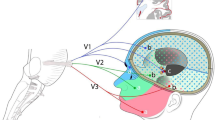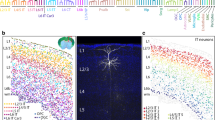Abstract
The neurotransmitters used by the sensory neurones of the dorsal root ganglia (DRG) are unknown. A proportion of these cells contain physiologically active peptides; for example, sub-populations of small-diameter neurones contain substance P or somatostatin1,2. Although these peptides probably have some influence on synaptic transmission in the dorsal horn of the spinal cord, their status as neurotransmitters is uncertain and it is possible that they coexist with conventional neurotransmitters. In addition, the neurones containing identified peptides account for only a fraction of the DRG sensory neurones2,3. There is evidence that the DRG contain catecholamines within fibres thought to be autonomie, but these substances have not been found within the sensory cell bodies themselves4,5. Moreover, the apparently inappropriate, inhibitory physiological effect of catecholamines in the dorsal horn6,7 has argued against their being primary sensory neurotransmitter molecules. We have used here antisera against tyrosine hydroxylase (TH; EC 1.14.16.2) and dopamine-β-hydroxylase (DBH; EC 1.14.17.1), two enzymes specific to catecholaminergic cells8–10, to show that a subpopulation of rat DRG neurones is catecholaminergic and that the neurotransmitter they make is probably dopamine. We believe this to be the first report of catecholaminergic sensory neurones.
Similar content being viewed by others
References
Hokfelt, T. et al. Neuroscience 1, 131–136 (1976).
Nagy, J. I. & Hunt, S. P. Neuroscience 7, 89–97 (1982).
Hokfelt, T., Johannson, O., Ljungdahl, A., Lundberg, J. M. & Schultzberg, M. Nature 284, 515–521 (1980).
Lackovic, Z. & Neff, N. H. Brain Res. 193, 289–292 (1980).
Owman, C. & Santini, M. Acta physiol. scand. 68, 127–128 (1966).
Headly, Duggan, A. W. & Griersmith, B. T. Brain Res. 145, 185–189 (1978).
Engberg, I. & Ryall, R. W. J. Physiol., Lond. 185, 298–322 (1966).
Fuxe, K. et al. Psychopharmacology: A Generation of Progress (eds Lipton, M. A., DiMascio, A. & Killam, K. F.) 67–91 (Raven, New York, 1978).
Joh, T. H., Oeghman, C. & Reie, D. J. Proc. natn. Acad. Sci. U.S.A. 70, 2767–2771 (1973).
Geffen, L. B. & Jarrott, B. Handbk Physiol. 2nd edn, Vol. 15, 527–571 (1978).
Sternberger, L. A., Hardy, P. H., Cucilis, J. & Myer, H. J. Histochem. Cytochem. 18, 315–333 (1970).
Lawson, S. N., Caddy, K. W. T. & Biscoe, T. J. Cell Tissue Res. 153, 399–413 (1974).
Lewis, S. Y., Rush, R. A. & Geffen, L. B. Brain Res. 134, 173–179 (1977).
De La Torre, J. C. J. Neurosci. Meth. 3, 1–5 (1980).
McDonald, D. M. & Blewett, R. W. J. Neurocytol. 10, 607–643 (1981).
Teitelman, G., Baker, H., Joh, T. H. & Reis, D. J. Proc. natn. Acad. Sci. U.S.A. 76, 509–513 (1979).
Specht, L. A., Pickel, V. M., Joh, T. H. & Reis, D. J. J. comp. Neurol. 199, 255–276 (1981).
Cochard, P., Goldstein, M. & Black, I. B. Proc. natn. Acad. Sci. U.S.A. 75, 2986–2990 (1978).
Katz, D. M., Markey, K. A., Goldstein, M. & Black, I. B. Soc. Neurosci. Abstr. 8, 8 (1982).
Author information
Authors and Affiliations
Rights and permissions
About this article
Cite this article
Price, J., Mudge, A. A subpopulation of rat dorsal root ganglion neurones is catecholaminergic. Nature 301, 241–243 (1983). https://doi.org/10.1038/301241a0
Received:
Accepted:
Issue Date:
DOI: https://doi.org/10.1038/301241a0
- Springer Nature Limited
This article is cited by
-
The differences in the anatomy of the thoracolumbar and sacral autonomic outflow are quantitative
Clinical Autonomic Research (2024)
-
Nociceptive DRG neurons express muscle lim protein upon axonal injury
Scientific Reports (2017)
-
Inhibition of Tetrodotoxin-Resistant Sodium Current in Dorsal Root Ganglia Neurons Mediated by D1/D5 Dopamine Receptors
Molecular Pain (2013)
-
Highly Localized Interactions between Sensory Neurons and Sprouting Sympathetic Fibers Observed in a Transgenic Tyrosine Hydroxylase Reporter Mouse
Molecular Pain (2011)
-
Retrograde Axonal Transport of Dopamine Beta Hydroxylase Antibodies by Neurons in the Trigeminal Ganglion
Neurochemical Research (2005)





